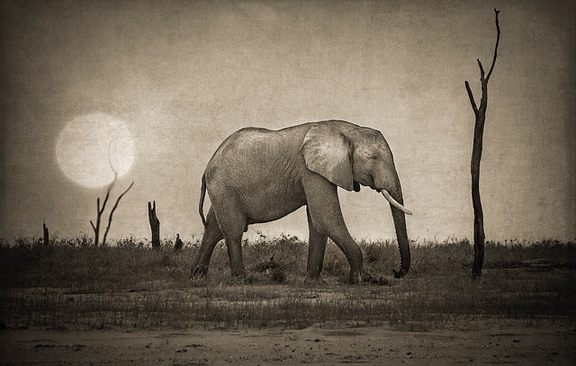
PenRod
Elephant Profile with Sun.
It’s an elephant in the valley of the Zambezi River in Zimbabwe, but it has been pulled out of time. It could be an image from the early history of photography, or a film still, or a postcard. But the image is actually quite recent, the years added to convey an urgent message.
The photograph is part of “Vanishing Zimbabwe,” a show of work by PenRod Cook — a.k.a. the wife-husband duo of Penrhyn and Rod Cook — with Sven Martson, running now at Kehler Liddell Gallery in Westville through April 16. The show is the result of the three photographers’ recent trip to Zimbabwe to practice wildlife photography — and in the process, document a region and an animal population in decline.

Antelope.
Martson’s more straightforward approach to photography — he “prefers to find images,” he says in an artistic statement — can be seen toward the back of the gallery, where he captures animals in blurry action, others in wary repose, and is attracted to the same forest of dead trees that captured the Cooks’ eyes. Martson captures his scenes almost like a journalist; his action shots put us there, sometimes to the point where it’s easy to imagine the smell of the dust.
By contrast, the Cooks subject their images to a series of transformations, to create a certain aesthetic and to make a point. They use digital cameras, “which are wonderful, quite frankly,” said Rod Cook, who shot film for decades earlier in the duo’s career. “This is a whole different ball game.” Cook guessed that they had taken tens of thousands of pictures between the two of them. They culled them down to about 200 each. “Then we throw them all in the pot,” editing them down further to “what we think is worth doing” — that is, subjecting the images to further manipulation in Photoshop.
“There are two important things that happen with almost every image,” Cook said. “The background, if it’s getting in the way, we tend to just throw it out of focus.” Then they “add layers of texture — sometimes many layers, sometimes just one or two.” The process can take an hour or several hours.
The overall effect is to make the pictures look old and weathered. That has its own point: because, soon, “the animals are going to be gone,” Cook said, due to “all the various influencing factors that are causing them to go extinct.” A major factor used to be poaching, but “it’s been curtailed quite a bit,” Cook said. The animals now face larger and much more uncontainable threats, “global warming and overpopulation” from humans, which is steadily reducing the size and the sustainability of the animals’ habitat. “Eventually they’re just going to end up in zoos.”

Wild Dogs Leaping.
Cook mentioned in particular the wild dog packs that they photographed. “They’re so ugly they’re cute,” he said. The Cooks learned that, in the region in which they did their photography, there were once nine individual packs about two years ago, “and now there’s only two,” Cook said. “That doesn’t mean they’re not in another country, but they’re definitely disappearing.” The elephant population there has declined by 70 or 80 percent. “There are still a lot of them around,” he said, but that’s because “they’re kept to a relatively small space” compared to the past.
The animals, in short, “are vanishing,” he said.
Taken in all at once — and the Whalley Avenue gallery is full of their images — the Cooks’ works take on the tone of an elegy, the animals seeming almost like ghosts already. That they don’t train their cameras only on the elephants and zebras, but include the dogs that are more familiar to us, makes the larger point, too, that the problem they documented in Zimbabwe isn’t unique to Zimbabwe. Global warming and the loss of habitat due to human development is affecting plants and animals everywhere. Connecticut has its own list of endangered animals, among them birds, turtles, frogs, and insects. According to the Department of Energy and Environmental Protection, climate change threatens cold water streams, forested swamps, tidal marshes, and other habitats, and has affected forest health.
“It’s a good time to be old,” Cook said, sardonically. In that statement, he acknowledges the general consensus of the scientific community that we waited too long to do anything about it; climate change has happened, and the clock cannot be turned back. Part of accepting that involves mourning what’s lost. And for those of us with many years ahead of us — and our children — there’s then looking forward, adapting to an uncertain future.
“Vanishing Zimbabwe” runs at Kehler Liddell Gallery, 873 Whalley Ave., through April 16. Visit the gallery’s website for hours and more information.